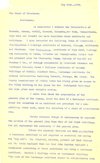“…the acts of to-day will affect distant generations:” Building the Campus
On 14 April 1909 Murray reported on the visit he and W.J. Rutherford, Dean of Agriculture, made to Saskatoon regarding a potential site for the campus. He indicated Rutherford would submit a separate report on the soil conditions – an extremely important aspect as the College of Agriculture would include a working farm. Murray went on to report on his favoured spot:
"I strongly recommend the site on the plan attached. It has a frontage of at least half a mile on the river. Its greatest depth is 2 miles and greatest width is 1 ½ miles. It contains 1,094 acres. The site facing the river is high & the view is excellent. Through the site a water main has been laid to Sutherland. With the CPR Company’s consent this can be tapped and an abundant supply of water for the University and the Farm [can be maintained].” He goes on to indicate nearby lands owned by the City, and possible additional lands which might be acquired by the University. “The other sites inspected seem to me to be quite indifferent for University purposes and I therefore do not recommend any of them. Of these sites the one on Caswell hill is probably the best.” [Current site of St. Paul’s Hospital] Included is Rutherford’s report on the soil, a “chocolate loam” with “practically no waste land."
Murray also reported on his visits to various campuses; discussions regarding architectural firms, etc. He visited “the Universities of Toronto, Queens, McGill, Harvard, Columbia, New York, Pennsylvania, Bryn Mawr and Cornell” and reviewed the architectural firms responsible for designing buildings for these, as well as for Chicago, Oklahoma, California, Washington University at St. Louis, Princeton and Wisconsin. “Nearly everyone though[t] it unnecessary to separate the problem of the general plan from that of our first buildings; but all emphasized the necessity of the general plan.”
Murray was responsible, too, for recommending the architects, and suggested “Of Canadian firms experienced in University Architecture I believe Brown & Vallance would suit us best.”
The Drinkle Building was rented to serve as the University’s first home, while its permanent buildings were under construction.
The architectural firm of Brown and Vallance were hired and established a general plan, emphasizing the riverbank, which was intended as the main axis with the University’s “monumental buildings…placed on the most beautiful sites.” At right angles to this, another axis running east-west would connect Agriculture and the University farm with the rest of the campus.
As one landscape architect noted, the campus was “almost unprecedented in size as far as a University is concerned.” The area suggested for the science buildings, for example, “we were told would ultimately be too small but…occupies a greater area than the whole of McGill University.” Within such an expanse, it is perhaps not surprising that early images of the campus are notable for their great open spaces, the buildings almost resembling something alien dropped haphazardly on the prairie. They were, however, following an ambitious plan: one which began with Agriculture and the sciences, and which, due to time and chance, never fully materialized as originally envisioned.
Nevertheless, a visitor to the province before the first world war stated that “the University of Saskatchewan is the most startling thing I saw in the West.” Noting the transient nature of much of western development – “the note of change, of rapid and amazing and unpredictable change” – the University by comparison was “obviously built to last for five or six hundred years. … The University at Saskatoon cries aloud to the West that the acts of to-day will affect distant generations.”
Despite the difficulties to come – war, fire, Depression – Murray managed to establish a well-planned campus, extraordinarily coherent in its architecture and grounds, and from the start, a source of pride both for those fortunate enough to study and work at the University, and for the province it serves.
Related Items
Correspondence with architects Brown and Vallance:
Building the University of Saskatchewan
A Halifax colleague of Murray’s noted E.B. Mitchell had referred to Murray in her book, incorrectly citing Murray’s birthplace as Pictou County. “You will have to be born again.” [Page 1 | Page 2]


















